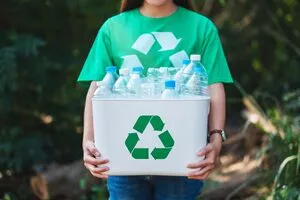In a world grappling with the consequences of rapid industrialization and overconsumption, the recycling journey stands out as a beacon of hope, offering a tangible solution to the escalating challenges of waste management and environmental degradation. The sheer volume of waste generated by modern societies has reached alarming proportions, polluting land, water, and air. Recycling emerges as a potent antidote to this crisis, addressing not only the symptoms but also the root causes of environmental harm.
This process goes beyond mere waste disposal; it symbolizes a fundamental shift in our relationship with resources. Rather than viewing materials as disposable, the recycling journey encourages a mindset that values the inherent worth of every item. It challenges the prevailing linear model of extraction, production, consumption, and disposal, advocating for a circular approach that emphasizes sustainability and resource efficiency.
At its core, recycling is a manifestation of the principles of a circular economy, a concept that envisions a regenerative system where waste is minimized, and the lifespan of products is extended. The transformation of discarded materials into valuable resources becomes a cyclical dance, where each step in the journey contributes to breaking the chains of relentless resource depletion and environmental harm. In embracing recycling, we embark on a collective journey towards a more sustainable future, one where our actions today resonate positively for generations to come.
The Collection Phase: Gateway to Recycling
Beyond the grassroots efforts of households, the collection phase of recycling extends its reach through organized collection systems and recycling facilities. These facilities act as hubs where materials are aggregated, processed, and prepared for their next life. Advanced sorting technologies within these facilities enhance the efficiency of the entire process, ensuring that materials are systematically separated into distinct streams. From conveyor belts and optical scanners to manual sorting stations, these facilities employ a combination of human ingenuity and technological advancements to optimize the sorting process.
The significance of organized collection systems cannot be overstated. They provide an avenue for businesses, institutions, and communities to responsibly dispose of their waste. This integration of commercial and industrial entities into the recycling ecosystem is paramount, as it addresses the substantial waste generated beyond individual households. Moreover, the collaboration between local governments and private enterprises in developing robust collection systems ensures a more comprehensive approach to recycling, reaching every corner of society.
Recycling facilities, equipped with state-of-the-art machinery, take center stage in the material transformation process. These facilities not only contribute to waste reduction but also serve as engines of innovation. Research and development initiatives within these facilities explore novel methods to enhance the recyclability of materials and improve overall efficiency. As technological advancements continue to reshape the recycling landscape, these facilities emerge as catalysts for change, driving the industry towards greater sustainability.
Sorting and Processing: Unveiling the Potential Within
The sorting and processing phase, propelled by technological advancements, goes beyond mere segregation. Automated sorting systems utilize optical sensors and sophisticated algorithms to distinguish materials based on color, shape, and composition. Magnetic separators efficiently extract ferrous metals, while eddy current separators remove non-ferrous metals, enhancing the precision of the sorting process. These innovations not only expedite the process but also contribute to the purity of material streams, ensuring that contaminants are minimized, and the recycled materials maintain their integrity.
Chemical processes play a pivotal role in breaking down complex materials into their fundamental components. For plastics, depolymerization processes transform them into monomers, ready to be polymerized anew. Metals undergo smelting, melting away impurities and leaving behind a pure, malleable form ready for reshaping. Paper, subjected to pulping, reverts to its fiber state, ready to be reconstituted into various paper products.
This intricate dance of technology and chemistry results in raw materials that serve as versatile building blocks for an extensive array of products. Recycled plastics, for instance, find their way into the creation of durable and eco-friendly clothing, reducing the reliance on virgin polyester. Repurposed aluminum from recycled cans becomes an essential component in the manufacturing of new containers, closing the loop on aluminum production and diminishing the need for extracting fresh bauxite.
The Manufacturing Rebirth: From Waste to New Products
As sorted and processed materials undergo their metamorphosis into raw components, they usher in a new era within the manufacturing sector. Industries committed to sustainable practices embrace recycled materials as a means of not only reducing their environmental footprint but also fostering innovation. The integration of recycled plastics, for instance, becomes integral in the production of various items, from durable packaging to innovative building materials. This shift not only diverts materials from landfills but also stimulates creativity in product design, as manufacturers explore novel applications for recycled resources.
The manufacturing rebirth signifies a paradigm shift from the linear model of take, make, and dispose to a circular model that prioritizes longevity and sustainability. The reincarnation of materials into new products not only conserves resources but also minimizes energy consumption compared to the energy-intensive production of goods from raw materials. This phase in the recycling journey is a testament to the economic viability of sustainable practices, showcasing that environmental stewardship and industrial progress can coexist harmoniously.
Moreover, the adoption of recycled materials in manufacturing contributes to a virtuous cycle by creating a market for secondary raw materials. This economic demand, in turn, fuels the recycling industry, encouraging further technological advancements and research in sustainable practices. The collaboration between the recycling and manufacturing sectors becomes a catalyst for positive change, illustrating that responsible resource management is not only environmentally sound but also economically rewarding.
Closing the Loop: Consumer Choices and Sustainable Practices

The recycling journey comes full circle when consumers actively choose products made from recycled materials, closing the loop on the circular economy. Educating the public about the environmental impact of their choices is key to fostering a culture of sustainability. When consumers opt for recycled goods, they contribute to the demand for recycled materials, incentivizing industries to further integrate sustainable practices into their production processes.
Furthermore, sustainable practices extend beyond recycling to encompass reduce and reuse. The concept of extended producer responsibility emphasizes that manufacturers are accountable for the entire life cycle of their products, encouraging the design of items with longevity and recyclability in mind. Through mindful consumption and waste reduction, individuals play a pivotal role in ensuring the success and continuity of the recycling journey.
In conclusion, the recycling journey represents a transformative cycle that turns waste into valuable resources. From the initial collection phase driven by individual actions to the manufacturing rebirth where materials find new purpose, the recycling process stands as a testament to human ingenuity and environmental responsibility. By embracing the principles of a circular economy, we can forge a sustainable path forward, where waste becomes a valuable commodity and our collective actions shape a more resilient and environmentally conscious world.


